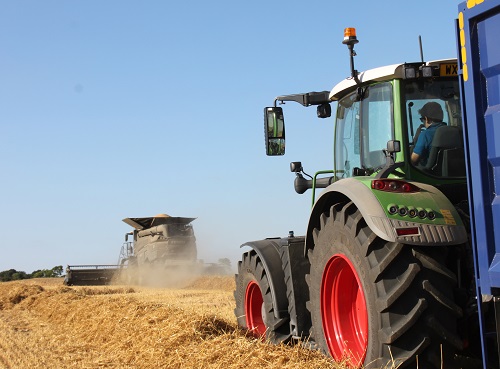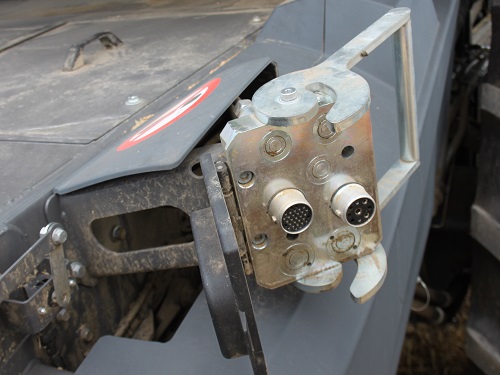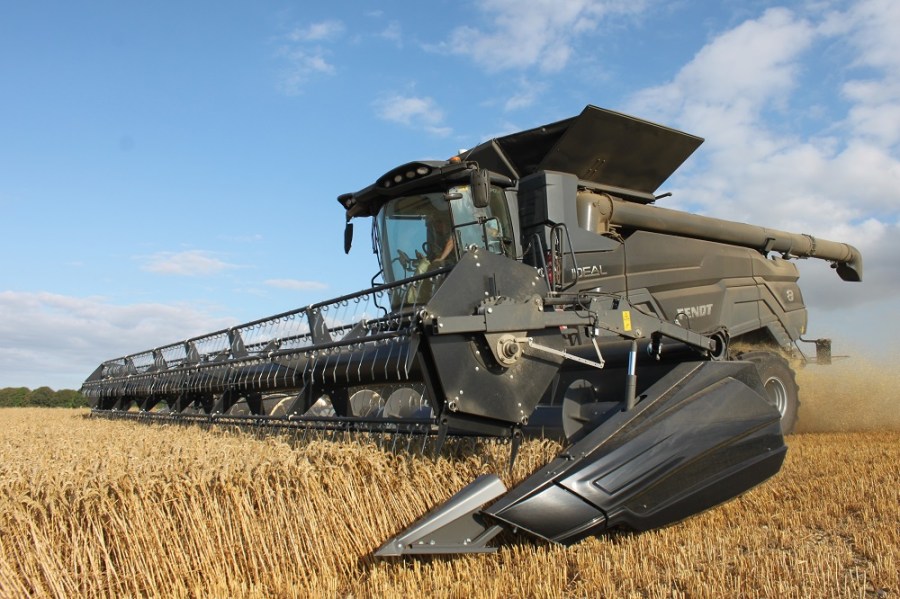AGCO’s all-new flagship combine line, the Fendt Ideal has cut its first swathes through British cereal crops. CPM was the first UK magazine to catch up with a demo model and learn more about Fendt’s plans.
This a complete clean-sheet design, so it’s not compromised by previous design limitations.
By Martin Rickatson
Settle down in the seat of a Fendt Ideal combine cab, and if you’re familiar with the brand’s larger tractors, things quickly become recognisable. From the armrest layout to the switchgear to the control terminal screen, there are common components and a similar operating logic.
While the brand’s tentative entry into the UK combine market has, until now, been based on machines whose main tractor/combine common feature is colour, with the clean-sheet-design of the Ideal there’s much more of a familiar feel to operating either of the two machine types. And following Fendt’s first field demonstrations this past summer to selected dealers and customers, the business’ management is making it clear there will be other factors existing Fendt users will find familiar should they choose to invest in an Ideal, such as the specific level of customer support Fendt users expect.

Existing owners of Fendt tractors will be a key target market for the Ideal.
“Until now, although we’ve sold small numbers of the X series hybrid twin-rotor models, Fendt has not had rotary machines to compete in this sector of the market with the largest combines available on the sorts of farms that very often are running our large tractors. It’s a segment where we believe we are the technology leader,” points out Richard Miller, Fendt marketing manager.
“By entering this sector of the combine market with the Ideal, we now have something to match this, and help develop the whole Fendt dealer offering for arable farmers further into the high capacity sector, complementing our high-hp wheeled and tracked tractor ranges.”
The Fendt Ideal combines have been designed, engineered and specified to sit squarely in the professional large-scale arable customer market, he suggests. There are three models in the line-up, boasting 450-647hp with up to 17,100 litres of grain tank capacity and 4.84m rotors (one in the smallest model, two in the larger two) for both threshing and separation.
“Ideal is aimed at professional users already familiar with the Fendt user interface, which has been developed from our tractor technology. We’re targeting those who require exceptional output and dealer support. And while many of those may be existing Fendt tractor users, others may currently operate other makes of combine. We know we’ve a lot to do to attract them, but we’re confident in the capability and reliability testing that’s gone into this design.
“At the same time, we’re confident in targeting this sector of the market because of the features we’ve developed. That includes, for example, some which have never before been seen in combine design, such as full from-the-cab header coupling/uncoupling. We understand the value of time to large-scale farm businesses, so have focused on things like this to help.”

Unique features include the Autodock automatic coupling system for engaging electrical and hydraulic connections and the PTO shafts.
At the same time, in light of AGCO’s evolution of its distribution strategy, the new combine gives the Fendt dealer network a product to further develop their relationship with large-scale customers, he points out. The result of a five-year, $200m (£154.5m) investment and a prototype programme that involved 50 machines tested worldwide, the Ideal was launched last year (see CPM Sept 2017 issue). Final production models were released in time for demonstrations during harvest 2018 and AGCO brought a number into the UK. In conjunction with Fendt dealers in key arable areas, these completed a demonstration programme across the country.
Along with the well reported key features of the machine, there are a number of other reasons these machines make a match for the brand’s tractors, suggests Fendt’s Ant Risdon, who’s co-ordinating the demo programme.
“These are combines that are much like the largest Fendt tractors – many of the features offer the highest output, the greatest convenience or the best use of technology in their class,” he maintains.
“Whilst most other machines on the market have evolved over time, this a complete clean-sheet design, so it’s not compromised by previous design limitations.
“But like Fendt tractors these combines have also been created to be compact and easy to handle. Getting combines moved quickly from field to field is critical to efficiency on large farms, and the Ideal has been designed so that, on 800mm tyres, all three models are less than 3.3m wide. With many combine buyers going to the additional expense of tracks simply to ensure large combines can squeeze between narrow road obstacles, this design makes that unnecessary. But, of course, for those who prefer tracks, we offer suspended units which, when specified at 26in width, ensure the combine is again no more than 3.3m wide.”
So if the Ideal is no wider than other combines, what makes AGCO sure it can compete with the largest combines on the market? The answer, says Ant, lies in the length of the Ideal’s internals – and specifically its rotors, said to be around twice as long as anything else available.
“From the elevator, a 600mm lateral rotor feeder is designed to present a smooth flow of material to the rotors, and stop them grabbing crop. To help ensure even feeding it’s synchronised at 70% of rotor speed. This means that if, for example, there’s some green straw in the rotors that’s slowing them down, the rotor feeder doesn’t carry on pushing through material at the same rate and causing overloading.
“The rotors transfer crop to a single 4.84m-long helix in the Ideal 7 and twin units in the Ideal 8 and 9, all with a 600mm diameter. We call them helixes rather than rotors as they have four distinct elements. First is a 530mm-long fluted spiral intake section to begin spinning the crop and building centrifugal force. Then there’s a 1,230mm-long threshing section, with two distinct flight types and two lots of four threshing bars, and concaves that provide 0.83m² of threshing area on the single-rotor Ideal 7 and 1.66m² on the Ideal 8/9.”
The design of these elements, which combine to create nearly 2,300mm of threshing length, means approximately 70-80% of separation has also taken place here by the time the crop moves through to the next stage of the rotor, claims AGCO.
“The remaining 20-30% is drawn out in the 2,460mm-long separation section that follows. Four helical rows of rotor fingers wind around the rotor, providing 1.44m² of separation area on the Ideal 7, 1.92m² on the Ideal 8 and 2.40m² on the Ideal 9. The rear element on all models is then a 618mm discharge section comprising rotor fingers and a discharge paddle.”
Beneath all of this is AGCO’s IdealBalance grain pan, a single unit that, on the two twin-rotor machines, is profiled to collect evenly from each rotor before transferring the threshed grain to the sieves. There’s up to 15% compensation to ensure an even load on side slopes.
“While other machines use one return pan below rotor pairs or drop threshed material straight onto the cleaning shoe, we use one pan at the front and one at the rear, each covering the length and width of both rotors and being sculpted to accept the material from each. With their side slope compensation of up to 15% and the fact the unit is split into two front and rear, there’s no need for 3D sieves or a slope-compensating cleaning shoe.”
On flatland standard and self-levelling ParaLevel models, grain ends up in a 12,500-litre tank with 140 l/sec unloading rate and single cross-auger. Optional on flatland 7 and 8 models and standard on the 9 is a 17,100-litre tank with 210 l/sec rate fed by a double cross-auger. When engaged, the gate covering the cross auger is progressively uncovered to minimise the shock load on it. On-board moisture and yield meters are both available.
At this point, it’s worth noting that there are a few more subtle differences than just power and grain tank size between the two larger combines, the Ideal 8 and 9. The latter also has a longer cleaning shoe, plus another elevator chain to handle higher amounts of material, and the aforementioned greater separation area, all of which is based on its greater power and therefore higher potential intake.
AGCO’s combine development engineers spent a lot of time studying the best way to evenly direct the air flow over the full length of the sieves, says Ant.
“While overall combine design is relatively narrow, there’s no substitute for sieve area, so the sieve elements are long and paired with a larger fan designed to operate at slower speed, for reduced power consumption and losses.”
At the rear, the 56/112-knife choppers are AGCO’s own. Chaff spreader deflectors can be set either manually or, from in the cab, electrically, to place material into the chopper, in a row or into the straw swath, or altered to counter cross-winds. A hydraulic spreader option helps take chopped straw across the full cut width. Cutterbar options range up to 12m and include Powerflow belt types.
Another focus was on reliability and ease of servicing, says AGCO, and to this end the rotor-only design of the Ideal combines means they have only 13 belts in total, half the number on AGCO’s now superseded hybrid combines.
“That means less maintenance and lower running costs, as well as lower power consumption,” suggests Ant.
“Again, because this is a clean-sheet design, we’ve been able to create something that’s developed from scratch for driveline simplicity, and ease of access for servicing.
“Rather than engage the threshing, unloading and header drives with over-centre belts, the Ideal uses wet clutches in an oil-filled drive centre. That means smooth engagement, low power absorption, no belt slippage and positive drive.”
Powering all this are six-cylinder engines, with a home-sourced 450hp/9.8-litre AGCOPower motor in the Ideal 7, a 538hp/12.4-litre MAN in the Ideal 8, and a 647hp, 15.2-litre unit from the same maker in the Ideal 9. All feature DEF/AdBlue emissions after-treatment.
“We’ve incorporated some technology developed by colleagues at the AGCO Gleaner combine plant in the US to improve cooling efficiency. The cooling pack is on the side of the engine, and the radiator fan features pivoting blades to reverse the airflow direction and blow the screen clean every few minutes depending on particular parameters: temperature, unloading auger engagement, road speed etc.
“On from the engine, there’s a two-range shift-on-the-move hydrostatic transmission capable of 40km/h. An intelligent 4wd system and diff lock are options, the former assessing wheelslip and drivetrain pressure and engaging 4wd on the move accordingly.”
One of AGCO’s key innovations with the Ideal is an innovative Auto Dock header remote connection system. In a claimed five seconds, once the header is hooked on, the coupling of hydraulic and electrical functions is automatic.
“That requires just one button press,” explains Ant. “It’s unique to AGCO and has the potential to save a lot of time, as well as improve operator safety.”
Fendt has also worked to give a familiar feel to the combines’ headland management system, he suggests.
“It’s possible to record and replay a number of functions to automatically take place on the headland. That might cover, for example, disengaging guidance, lifting the header, lowering the reel to clear the knife, and reduce cleaning fan speed. These can all be recorded in reverse for re-entering the crop, and can then be replayed automatically every time the combine meets or leaves the headland.”
In the cab, there’s a new AGCO unit operating the machine, first seen on the latest-generation RoGator self-propelled sprayers. It centres around the Fendt-familiar Varioterminal, compatible with Novotel or Trimble guidance systems. It’s also fully conversant with SIM data recording that speaks the same language as Gatekeeper and Farm Works. Using the primary HarvestPlus operating system, after entering desired minimum and maximum forward speeds on the screen, the operator then sets sensitivity values for set loss parameters – rotor losses, sieve losses and elevator load. The combine will then drive itself accordingly, within loss limits and output constraints. Machine to machine communication is possible, with data settings found to work well on one machine transferable wirelessly to another in the field.
Next season, potential customers will also be able to specify optional Ideal Plus, a crop visualisation system which uses 52 acoustic sensors to measure throughput and allow it to self-adjust based on this data. An optional element of this is a grain quality camera, sited at the top of the clean grain elevator, which takes a photo for every paddle stroke. By identifying broken grains and material other than grain, this allows the operator and the machine to then respond accordingly.
It’s also possible for an owner or manager nearby to, for example, examine the swath for losses and manage combine settings via an iPad to perhaps help an inexperienced driver make fine-tuning adjustments.
So while all of this packs a lot of promise, when will Fendt dealers be able to offer the product to customers?
“This season gave us a chance to show farmers what the Ideal can do. For harvest 2019, we will have a small number of units ready for retail, via selected, fully trained and resourced dealers,” says Ant.
AGCO Fendt Ideal
- Engine: 450hp/9.8-litre AGCOPower (Ideal 7), 538hp/12.4-litre MAN (Ideal 8), 647hp/15.2-litre MAN (Ideal 9). All with six cylinders, turbocharging and intercooling. DEF/AdBlue aftertreatment
- Transmission: Two-range hydrostatic, 40km/h maximum speed on both tracked and wheeled versions
- Cutterbar options: Freeflow or Powerflow 7.7-12.2m. AutoDock hydraulic/electrical service coupling as standard
- Rotors: One in the Ideal 7, two in the Ideal 8 and Ideal 9. Length: 4,840mm. Diameter 600mm. Responsible for threshing and separation
- Grain tank capacity: 12,500 litres with 140 l/sec unloading rate (Ideal 7 and 8) or 17,100 litres with 210 l/sec unloading rate (Ideal 9)




